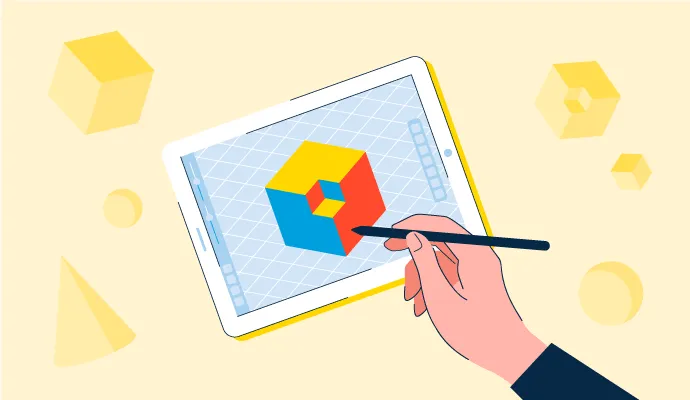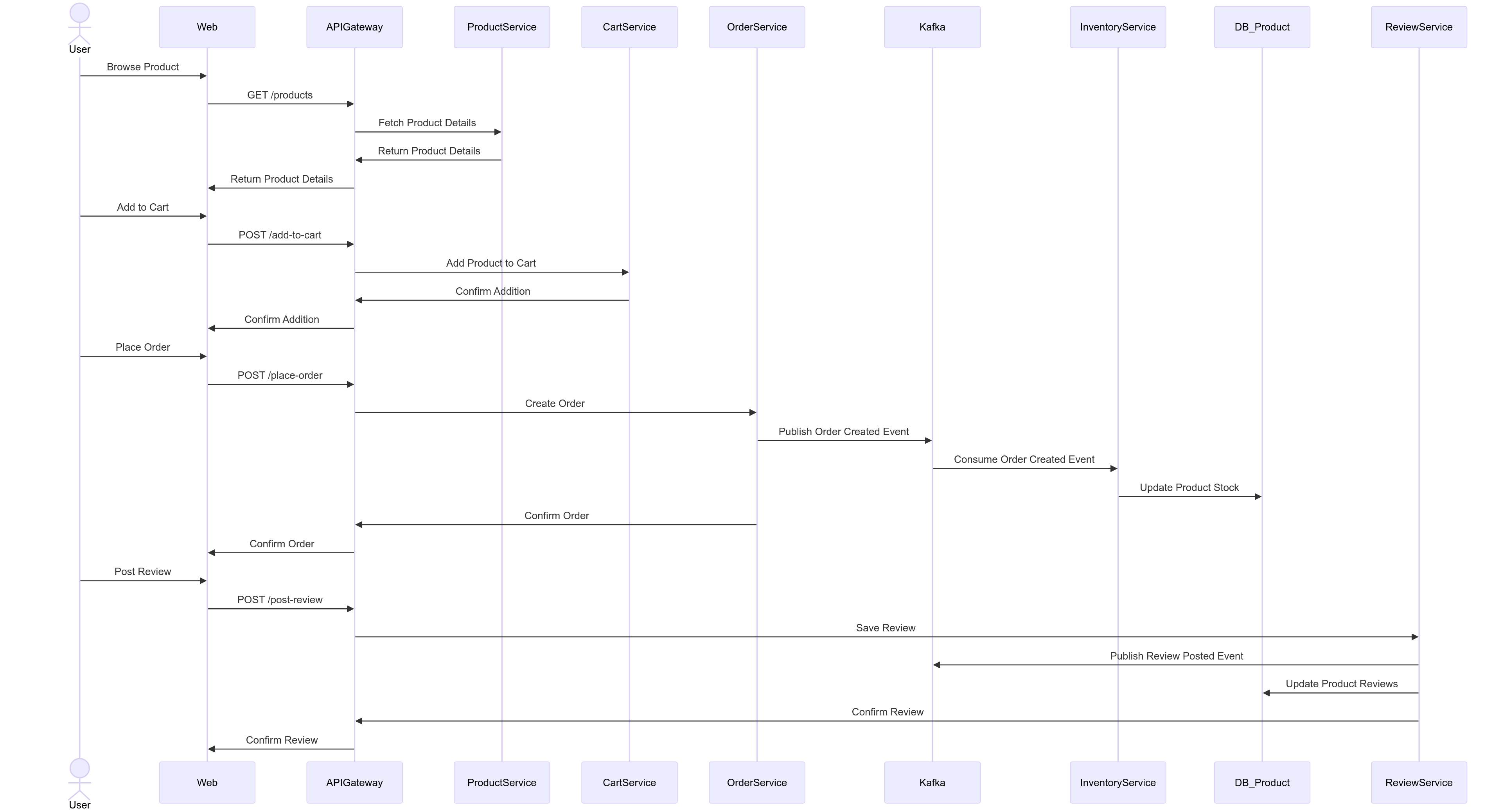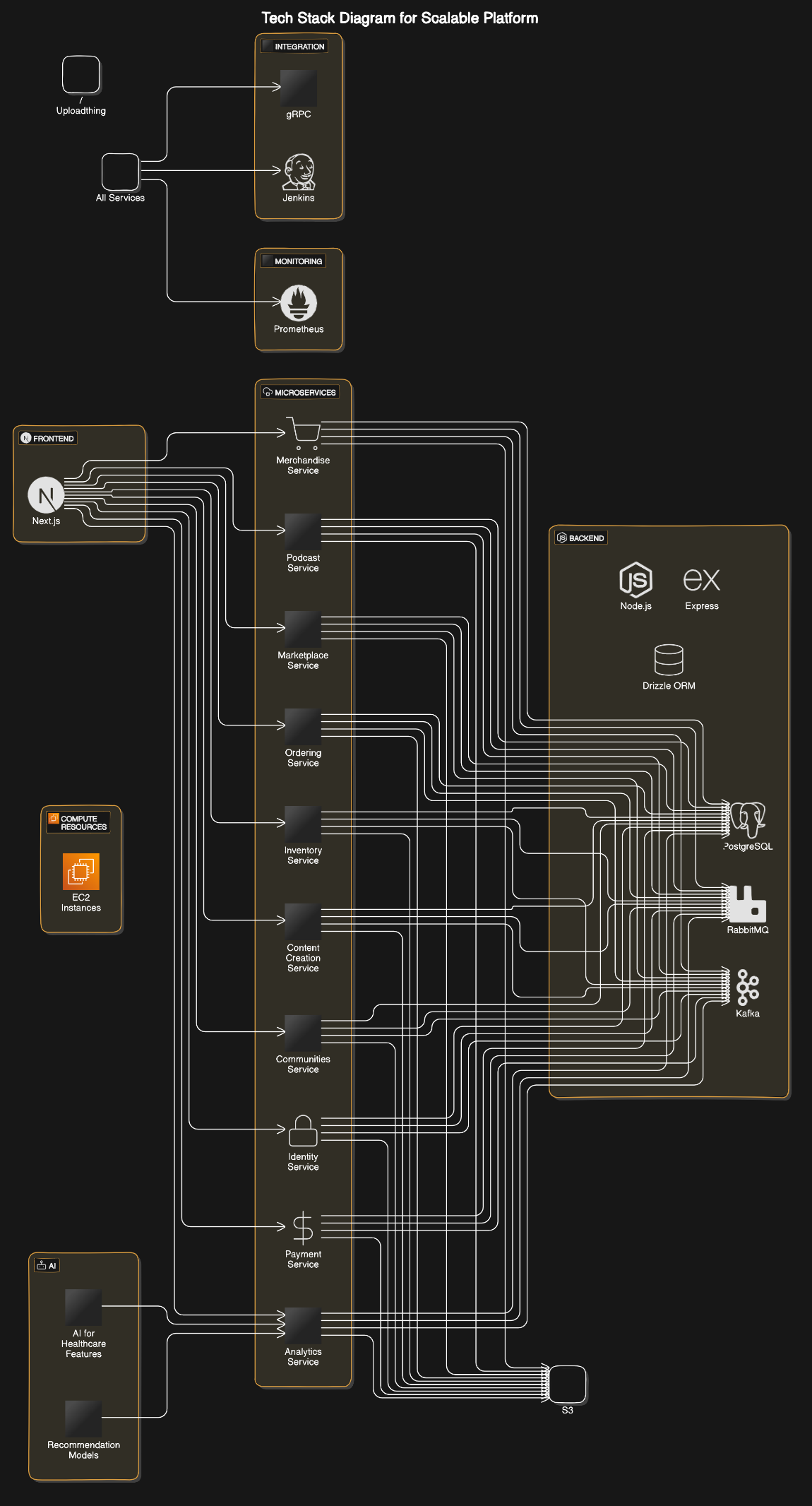System Architecture and planning
 Razzaq Shikalgar
Razzaq Shikalgar
System Objective
The goal is to build a scalable, high-performance platform that combines features from Amazon and Reddit. This platform will provide a seamless user experience across various domains, including merchandise, podcasts, marketplace, ordering, inventory, content creation, communities, identity management, payment processing, and analytics. Additionally, AI will be integrated for healthcare features and recommendation models.
Core Building Blocks
Backend Technologies
Node.js: A runtime environment for building fast and scalable server-side applications.
Express: A web application framework for Node.js, facilitating routing and middleware management.
Drizzle ORM: Provides type-safe and scalable database interactions with PostgreSQL, enhancing developer productivity.
PostgreSQL: A relational database for robust data storage and management, supporting ACID transactions.
Microservice Architecture: Decomposes the application into loosely coupled services, allowing for independent development and deployment.
RabbitMQ: A reliable message broker for communication between microservices, ensuring message delivery with advanced routing capabilities.
Kafka: A distributed event streaming platform for real-time data processing and integration, ensuring high throughput and durability.
EC2 Instances: Provides scalable compute resources for hosting the application.
S3 / Uploadthing: Used for cloud storage and handling frontend file uploads.
Frontend Technologies
- Next.js: A framework for server-side rendering, static site generation, and client-side rendering, ensuring a highly scalable and performant frontend.
Communication and Integration
gRPC: Enables efficient communication and interface definition between services, providing high performance and low latency.
Jenkins: Facilitates continuous integration and continuous deployment (CI/CD) for streamlined development processes.
Monitoring and Maintenance
- Prometheus: A monitoring tool for system metrics and alerting, ensuring system reliability and performance.
Core Domains
Merchandise
Product listing, searching, and filtering.
Shopping cart, checkout, and payment integration.
Inventory management and order fulfillment.
Podcasts
Podcast creation, hosting, and distribution.
User subscriptions and recommendations.
Marketplace
User-to-user transactions.
Listing and buying of products.
Ordering
Order management system.
Integration with payment gateways.
Inventory
Real-time inventory tracking.
Automated restocking alerts.
Content Creation
Tools for creating and managing user-generated content.
Moderation and enforcement of community guidelines.
Communities
Forums, discussions, and user interactions.
User roles and permissions.
Identity Management
User authentication and authorization.
Profile management and security.
Payment Processing
Secure payment processing.
Support for multiple payment methods.
Analytics
Real-time data analytics and reporting.
User behavior tracking and insights.
Domain-Driven Design (DDD)
Employ DDD principles to model core domains, defining aggregates, entities, value objects, repositories, and services. This approach ensures clear boundaries and interactions between domains.
AI and Recommendation Models
AI for Healthcare Features: Integrate machine learning models to provide healthcare recommendations and insights.
Recommendation Models: Utilize collaborative filtering and content-based filtering to deliver personalized user recommendations.
System Design
Architecture Diagram

Sequence Diagram

Tech Stack Diagram

Important Considerations
Scalability
Use auto-scaling groups for EC2 instances to handle varying loads.
Distribute load using load balancers to optimize resource utilization.
Employ a microservice architecture to allow independent scaling of services.
Data Consistency
Utilize PostgreSQL for ACID compliance in transactions.
Implement eventual consistency for distributed services.
Security Measures
Implement robust authentication and authorization mechanisms.
Use encryption for data at rest and in transit.
Conduct regular security audits and compliance checks.
Traffic Spikes Handling
Use caching mechanisms like Redis or Memcached to reduce load on the database.
Implement rate limiting and throttling to manage sudden traffic spikes.
Ensure auto-scaling and load balancing are in place to handle increased demand.
Additional Considerations
Database Selection: NoSQL vs PostgreSQL
NoSQL Databases: Ideal for flexible, schema-less data storage, suitable for applications requiring rapid scaling and handling large volumes of unstructured data.
PostgreSQL: Preferred for applications needing ACID compliance, complex queries, and relational data storage, providing robust data integrity and support for advanced data types.
Why Use ORM (Object-Relational Mapping)
- Benefits: ORMs simplify database interactions, ensure type safety, and reduce boilerplate code. Drizzle ORM, in particular, offers a higher-level abstraction for database operations, improving developer productivity and code maintainability.
Why Choose Drizzle ORM
Type-Safe and Scalable: Designed for complex applications, Drizzle ORM ensures type safety and scalability.
Modern and Lightweight: Balances functionality and performance, making it suitable for contemporary applications.
Alternatives to Drizzle ORM
Sequelize: A well-established ORM for Node.js with extensive documentation and community support, supporting various relational databases.
TypeORM: Works seamlessly with TypeScript, providing decorators and a wide database support.
Prisma: Focuses on developer experience with an intuitive data modeling language and powerful type-safe queries.
Objection.js: Built on Knex.js, it supports advanced features like graph relations and provides a minimalist approach to ORM.
Advantages of Using Kubernetes
Scalability: Automatically scales applications based on demand.
Management: Simplifies deployment, scaling, and operations of application containers.
Portability: Supports multi-cloud and hybrid deployments.
Why RabbitMQ?
Reliable Message Broker: Ensures message delivery and provides advanced routing capabilities for inter-service communication.
Alternatives: Apache Kafka and AWS SQS can also be considered, with Kafka being preferable for high-throughput use cases.
Cloud Provider Selection: GCP vs AWS
AWS: Offers a wide range of services, a mature ecosystem, and a global presence, making it ideal for scalable and reliable infrastructure.
GCP: Provides competitive pricing, strong data analytics tools, and integration with Google services.
Frontend Framework: Next.js
- Next.js: Best suited for server-side rendering, static site generation, and building highly scalable React applications.
Microservice Architecture vs Monolith
Microservices Benefits
Independent Deployment: Each service can be deployed independently, minimizing downtime and reducing risk.
Scalability: Services can be scaled independently based on specific demands.
Maintenance and Development: Teams can work on different services simultaneously, enabling faster release cycles.
Fault Isolation: Failures in one service do not affect the entire system, enhancing resilience.
Technology Diversity: Teams can choose different technologies for different services based on specific needs.
Challenges of Microservices
Complexity: Managing multiple services increases deployment and monitoring complexity.
Data Management: Ensuring data consistency across services can be challenging.
Inter-Service Communication: Communication can introduce latency and requires robust protocols.
DevOps and Automation: Requires advanced practices for CI/CD and monitoring.
Monolith Benefits
Simplicity: A single codebase is easier to develop and manage, especially for smaller applications.
Performance: Internal function calls are typically faster than inter-service communication.
Development Speed: Initial development can be quicker without managing multiple services.
Challenges of Monolith
Scalability: Scaling typically involves scaling the entire application rather than specific components.
Maintenance and Development: As the application grows, the codebase can become large and complex.
Deployment Risk: Updating the entire application increases the risk of introducing bugs.
Technology Lock-In: Difficult to change technology stacks without significant refactoring.
High-Level User Authentication Tech Stack
JWT or Paseto: Utilize token-based authentication for secure user sessions.
OAuth: Implement for third-party integrations, allowing users to authenticate using existing accounts.
Auth0: Consider using Auth0 for a comprehensive authentication solution that simplifies user management.
Kafka's Role in the Application
Uses and Advantages
- Real-Time Event Streaming: Kafka enables efficient data integration and processing across microservices, ensuring high throughput and fault tolerance.
Forgot the name of authentication which was mentioned during call...
Subscribe to my newsletter
Read articles from Razzaq Shikalgar directly inside your inbox. Subscribe to the newsletter, and don't miss out.
Written by
